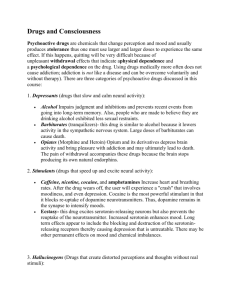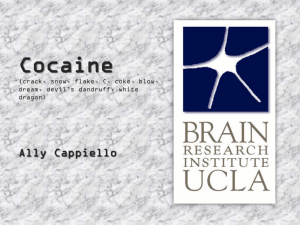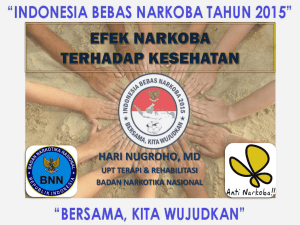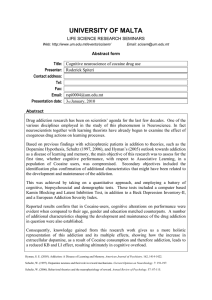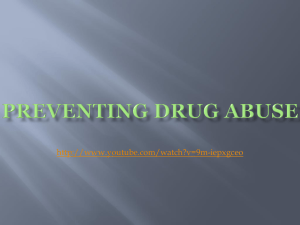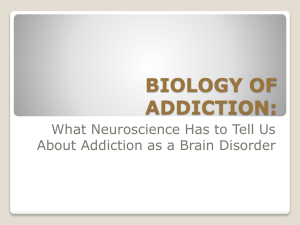Document 13564236
advertisement
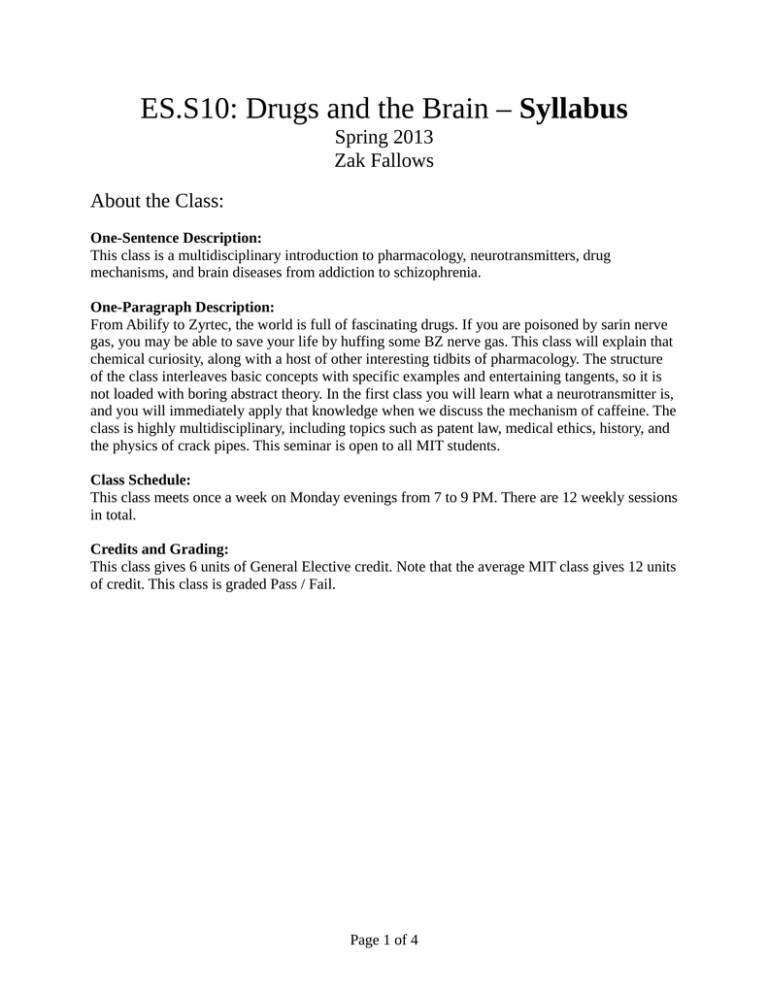
ES.S10: Drugs and the Brain – Syllabus � Spring 2013 � Zak Fallows � About the Class: One-Sentence Description: This class is a multidisciplinary introduction to pharmacology, neurotransmitters, drug mechanisms, and brain diseases from addiction to schizophrenia. One-Paragraph Description: From Abilify to Zyrtec, the world is full of fascinating drugs. If you are poisoned by sarin nerve gas, you may be able to save your life by huffing some BZ nerve gas. This class will explain that chemical curiosity, along with a host of other interesting tidbits of pharmacology. The structure of the class interleaves basic concepts with specific examples and entertaining tangents, so it is not loaded with boring abstract theory. In the first class you will learn what a neurotransmitter is, and you will immediately apply that knowledge when we discuss the mechanism of caffeine. The class is highly multidisciplinary, including topics such as patent law, medical ethics, history, and the physics of crack pipes. This seminar is open to all MIT students. Class Schedule: This class meets once a week on Monday evenings from 7 to 9 PM. There are 12 weekly sessions in total. Credits and Grading: This class gives 6 units of General Elective credit. Note that the average MIT class gives 12 units of credit. This class is graded Pass / Fail. Page 1 of 4 � Schedule of Topics: Week 1: Introduction How the brain works: neurons, synapses, and neurotransmitters Introducing some neurotransmitters: glutamate, GABA, serotonin, dopamine, and more Excitatory vs. inhibitory Receptor agonist vs. antagonist A few example drugs Week 2: Drug Mechanisms, Explained with Antidepressants The steps of neural signaling: action potential, neurotransmitter release, receptor binding How drugs work, using antidepressants as examples: Increase neurotransmitter (NT) synthesis Increase NT release Inhibit NT reuptake Inhibit NT breakdown Mimic the NT (receptor agonist) Partially mimic the NT (receptor partial agonist) Interfere with negative feedback (presynaptic antagonist) Week 3: Pharmacokinetics ADME: Absorption, distribution, metabolism, and excretion How dopamine signals facilitate reward-based learning and motivate behavior Dopamine’s central role in drug addiction Drugs that are absorbed faster are more addictive Routes of administration: IV injection, IM injection, smoking, and pills Ways to mess with ADME Week 4: Drug Addiction, Dopamine, and Liking vs. Wanting The definition of addiction These are not defining characteristics of addiction: Withdrawal Dependence Tolerance Liking vs. wanting: These are separate neurochemical phenomena Distinct neurotransmitters in each Distinct brain structures in each A cocaine addicts wants cocaine very badly, but he does not even like cocaine anymore, he does not enjoy it. Page 2 of 4 � Week 5: Action Potentials, Alcohol, and Shock Therapies Action potentials Local anesthetics Alcohol, and the many diseases caused by alcohol Shock therapies: inducing a seizure to (hopefully) promote health Week 6: Alcohol Antagonists Drugs that block or partially block the effects of alcohol Week 7: Dose-Response Curves Dose-response curves, log(dose)-response curves Partial agonists Inverse agonists Competitive and noncompetitive antagonists Explained by example with benzodiazepines Week 8: Anxiety and Sedatives The history of anxiolytics: bromides, barbiturates, benzodiazepines, SSRIs Anti-punishment effects More about GABA and GABA-A receptors Week 9: Psychosis, Antipsychotics, and Parkinson’s Disease Psychosis symptoms: Hallucinations Delusions Thought disorder Blunted and/or inappropriate emotions Cognitive impairment Lack of motivation Neurochemical basis of psychosis Types of antipsychotic: Dopamine antagonist Serotonin antagonist Benzodiazepines, nicotine, adrenergic antagonists Neurochemical basis for Parkinson’s Antipsychotic side effects are similar to Parkinson’s Week 10: The Two Dichotomies Dichotomy I: Sympathetic vs. Parasympathetic Dichotomy II: Vasoconstrictor vs. Vasodilator Viagra Cocaine and heart attacks Headaches and heart attacks in explosives factory workers Page 3 of 4 � Week 11: Recreational Drugs Stimulants: cocaine, methamphetamine, bath salts MDMA The underappreciated dangers of MDMA Sedatives: barbiturates, benzodiazepines, alcohol, Quaaludes Marijuana Opioids: heroin, methadone, OxyContin Psychedelics: LSD, psilocybin, mescaline Dissociative anesthetics: PCP, ketamine, dextromethorphan Deliriants: scopolamine, diphenhydramine Week 12: Appetite and Nausea, Syringes Neurotransmitters that cause nausea: serotonin, dopamine, opioids, and more Drugs that cause nausea Drugs that relieve nausea, especially ondansetron Weight-loss drugs (anorectics) Syringes Vein damage caused by chronic injecting Unsafe and disgusting syringe use Page 4 of 4 � MIT OpenCourseWare http://ocw.mit.edu ES.S10 Drugs and the Brain Spring 2013 For information about citing these materials or our Terms of Use, visit: http://ocw.mit.edu/terms.


